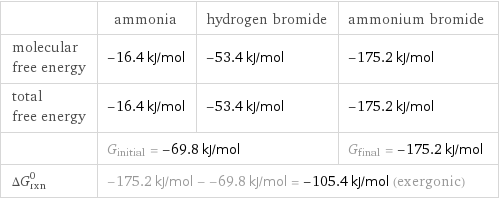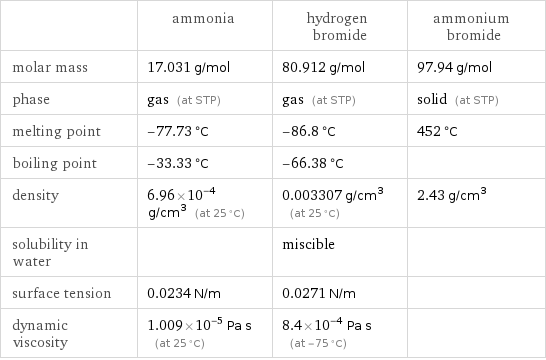Input interpretation

NH_3 (ammonia) + HBr (hydrogen bromide) ⟶ NH_4Br (ammonium bromide)
Balanced equation

Balance the chemical equation algebraically: NH_3 + HBr ⟶ NH_4Br Add stoichiometric coefficients, c_i, to the reactants and products: c_1 NH_3 + c_2 HBr ⟶ c_3 NH_4Br Set the number of atoms in the reactants equal to the number of atoms in the products for H, N and Br: H: | 3 c_1 + c_2 = 4 c_3 N: | c_1 = c_3 Br: | c_2 = c_3 Since the coefficients are relative quantities and underdetermined, choose a coefficient to set arbitrarily. To keep the coefficients small, the arbitrary value is ordinarily one. For instance, set c_1 = 1 and solve the system of equations for the remaining coefficients: c_1 = 1 c_2 = 1 c_3 = 1 Substitute the coefficients into the chemical reaction to obtain the balanced equation: Answer: | | NH_3 + HBr ⟶ NH_4Br
Structures

+ ⟶
Names

ammonia + hydrogen bromide ⟶ ammonium bromide
Reaction thermodynamics
Enthalpy

| ammonia | hydrogen bromide | ammonium bromide molecular enthalpy | -45.9 kJ/mol | -36.3 kJ/mol | -270.8 kJ/mol total enthalpy | -45.9 kJ/mol | -36.3 kJ/mol | -270.8 kJ/mol | H_initial = -82.2 kJ/mol | | H_final = -270.8 kJ/mol ΔH_rxn^0 | -270.8 kJ/mol - -82.2 kJ/mol = -188.6 kJ/mol (exothermic) | |
Gibbs free energy

| ammonia | hydrogen bromide | ammonium bromide molecular free energy | -16.4 kJ/mol | -53.4 kJ/mol | -175.2 kJ/mol total free energy | -16.4 kJ/mol | -53.4 kJ/mol | -175.2 kJ/mol | G_initial = -69.8 kJ/mol | | G_final = -175.2 kJ/mol ΔG_rxn^0 | -175.2 kJ/mol - -69.8 kJ/mol = -105.4 kJ/mol (exergonic) | |
Equilibrium constant
![Construct the equilibrium constant, K, expression for: NH_3 + HBr ⟶ NH_4Br Plan: • Balance the chemical equation. • Determine the stoichiometric numbers. • Assemble the activity expression for each chemical species. • Use the activity expressions to build the equilibrium constant expression. Write the balanced chemical equation: NH_3 + HBr ⟶ NH_4Br Assign stoichiometric numbers, ν_i, using the stoichiometric coefficients, c_i, from the balanced chemical equation in the following manner: ν_i = -c_i for reactants and ν_i = c_i for products: chemical species | c_i | ν_i NH_3 | 1 | -1 HBr | 1 | -1 NH_4Br | 1 | 1 Assemble the activity expressions accounting for the state of matter and ν_i: chemical species | c_i | ν_i | activity expression NH_3 | 1 | -1 | ([NH3])^(-1) HBr | 1 | -1 | ([HBr])^(-1) NH_4Br | 1 | 1 | [NH4Br] The equilibrium constant symbol in the concentration basis is: K_c Mulitply the activity expressions to arrive at the K_c expression: Answer: | | K_c = ([NH3])^(-1) ([HBr])^(-1) [NH4Br] = ([NH4Br])/([NH3] [HBr])](../image_source/fc63ef0678995643c491e7d5f79f6118.png)
Construct the equilibrium constant, K, expression for: NH_3 + HBr ⟶ NH_4Br Plan: • Balance the chemical equation. • Determine the stoichiometric numbers. • Assemble the activity expression for each chemical species. • Use the activity expressions to build the equilibrium constant expression. Write the balanced chemical equation: NH_3 + HBr ⟶ NH_4Br Assign stoichiometric numbers, ν_i, using the stoichiometric coefficients, c_i, from the balanced chemical equation in the following manner: ν_i = -c_i for reactants and ν_i = c_i for products: chemical species | c_i | ν_i NH_3 | 1 | -1 HBr | 1 | -1 NH_4Br | 1 | 1 Assemble the activity expressions accounting for the state of matter and ν_i: chemical species | c_i | ν_i | activity expression NH_3 | 1 | -1 | ([NH3])^(-1) HBr | 1 | -1 | ([HBr])^(-1) NH_4Br | 1 | 1 | [NH4Br] The equilibrium constant symbol in the concentration basis is: K_c Mulitply the activity expressions to arrive at the K_c expression: Answer: | | K_c = ([NH3])^(-1) ([HBr])^(-1) [NH4Br] = ([NH4Br])/([NH3] [HBr])
Rate of reaction
![Construct the rate of reaction expression for: NH_3 + HBr ⟶ NH_4Br Plan: • Balance the chemical equation. • Determine the stoichiometric numbers. • Assemble the rate term for each chemical species. • Write the rate of reaction expression. Write the balanced chemical equation: NH_3 + HBr ⟶ NH_4Br Assign stoichiometric numbers, ν_i, using the stoichiometric coefficients, c_i, from the balanced chemical equation in the following manner: ν_i = -c_i for reactants and ν_i = c_i for products: chemical species | c_i | ν_i NH_3 | 1 | -1 HBr | 1 | -1 NH_4Br | 1 | 1 The rate term for each chemical species, B_i, is 1/ν_i(Δ[B_i])/(Δt) where [B_i] is the amount concentration and t is time: chemical species | c_i | ν_i | rate term NH_3 | 1 | -1 | -(Δ[NH3])/(Δt) HBr | 1 | -1 | -(Δ[HBr])/(Δt) NH_4Br | 1 | 1 | (Δ[NH4Br])/(Δt) (for infinitesimal rate of change, replace Δ with d) Set the rate terms equal to each other to arrive at the rate expression: Answer: | | rate = -(Δ[NH3])/(Δt) = -(Δ[HBr])/(Δt) = (Δ[NH4Br])/(Δt) (assuming constant volume and no accumulation of intermediates or side products)](../image_source/257a80fc993326bfc508d1dfac06b545.png)
Construct the rate of reaction expression for: NH_3 + HBr ⟶ NH_4Br Plan: • Balance the chemical equation. • Determine the stoichiometric numbers. • Assemble the rate term for each chemical species. • Write the rate of reaction expression. Write the balanced chemical equation: NH_3 + HBr ⟶ NH_4Br Assign stoichiometric numbers, ν_i, using the stoichiometric coefficients, c_i, from the balanced chemical equation in the following manner: ν_i = -c_i for reactants and ν_i = c_i for products: chemical species | c_i | ν_i NH_3 | 1 | -1 HBr | 1 | -1 NH_4Br | 1 | 1 The rate term for each chemical species, B_i, is 1/ν_i(Δ[B_i])/(Δt) where [B_i] is the amount concentration and t is time: chemical species | c_i | ν_i | rate term NH_3 | 1 | -1 | -(Δ[NH3])/(Δt) HBr | 1 | -1 | -(Δ[HBr])/(Δt) NH_4Br | 1 | 1 | (Δ[NH4Br])/(Δt) (for infinitesimal rate of change, replace Δ with d) Set the rate terms equal to each other to arrive at the rate expression: Answer: | | rate = -(Δ[NH3])/(Δt) = -(Δ[HBr])/(Δt) = (Δ[NH4Br])/(Δt) (assuming constant volume and no accumulation of intermediates or side products)
Chemical names and formulas

| ammonia | hydrogen bromide | ammonium bromide formula | NH_3 | HBr | NH_4Br Hill formula | H_3N | BrH | BrH_4N name | ammonia | hydrogen bromide | ammonium bromide
Substance properties

| ammonia | hydrogen bromide | ammonium bromide molar mass | 17.031 g/mol | 80.912 g/mol | 97.94 g/mol phase | gas (at STP) | gas (at STP) | solid (at STP) melting point | -77.73 °C | -86.8 °C | 452 °C boiling point | -33.33 °C | -66.38 °C | density | 6.96×10^-4 g/cm^3 (at 25 °C) | 0.003307 g/cm^3 (at 25 °C) | 2.43 g/cm^3 solubility in water | | miscible | surface tension | 0.0234 N/m | 0.0271 N/m | dynamic viscosity | 1.009×10^-5 Pa s (at 25 °C) | 8.4×10^-4 Pa s (at -75 °C) |
Units
